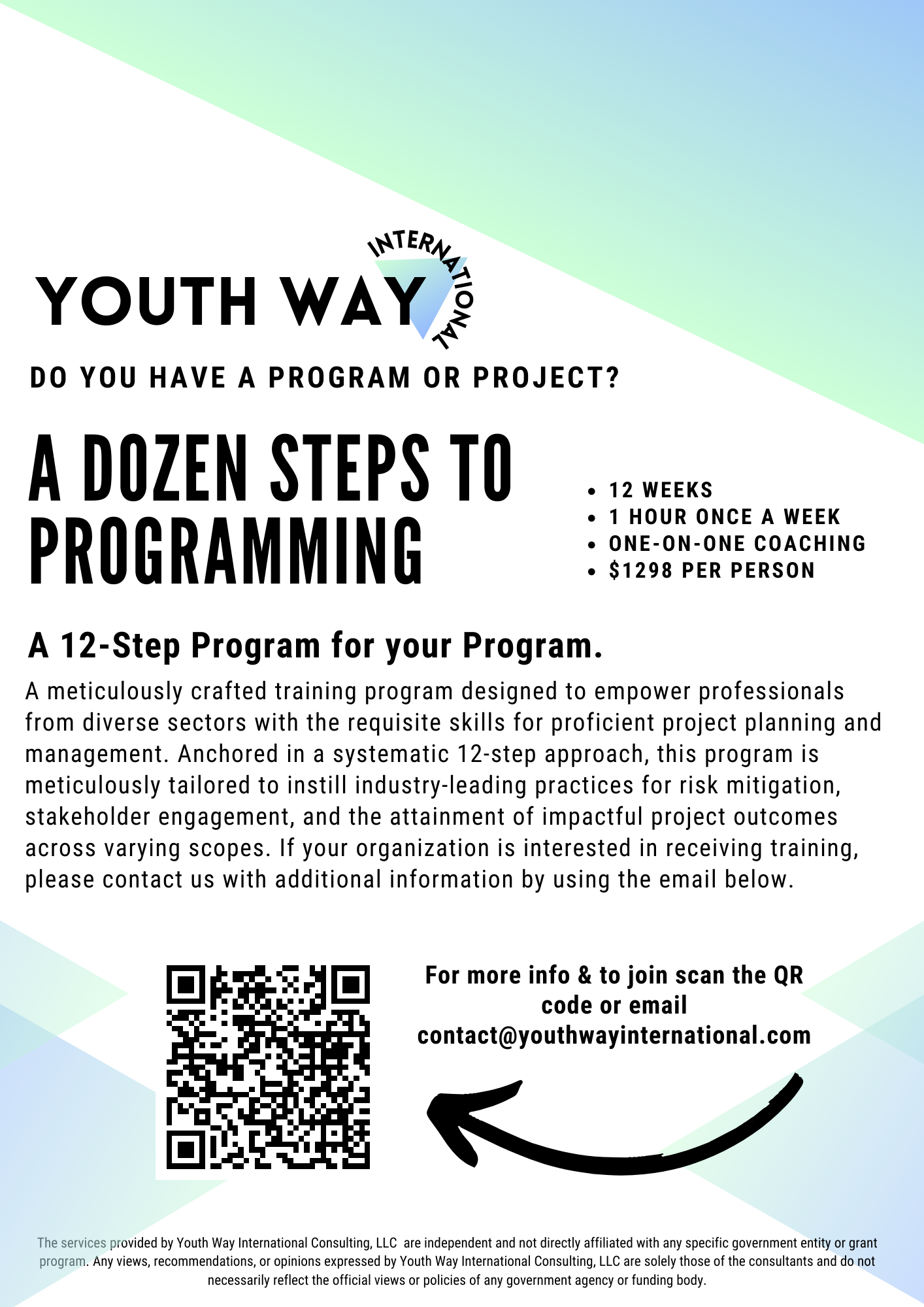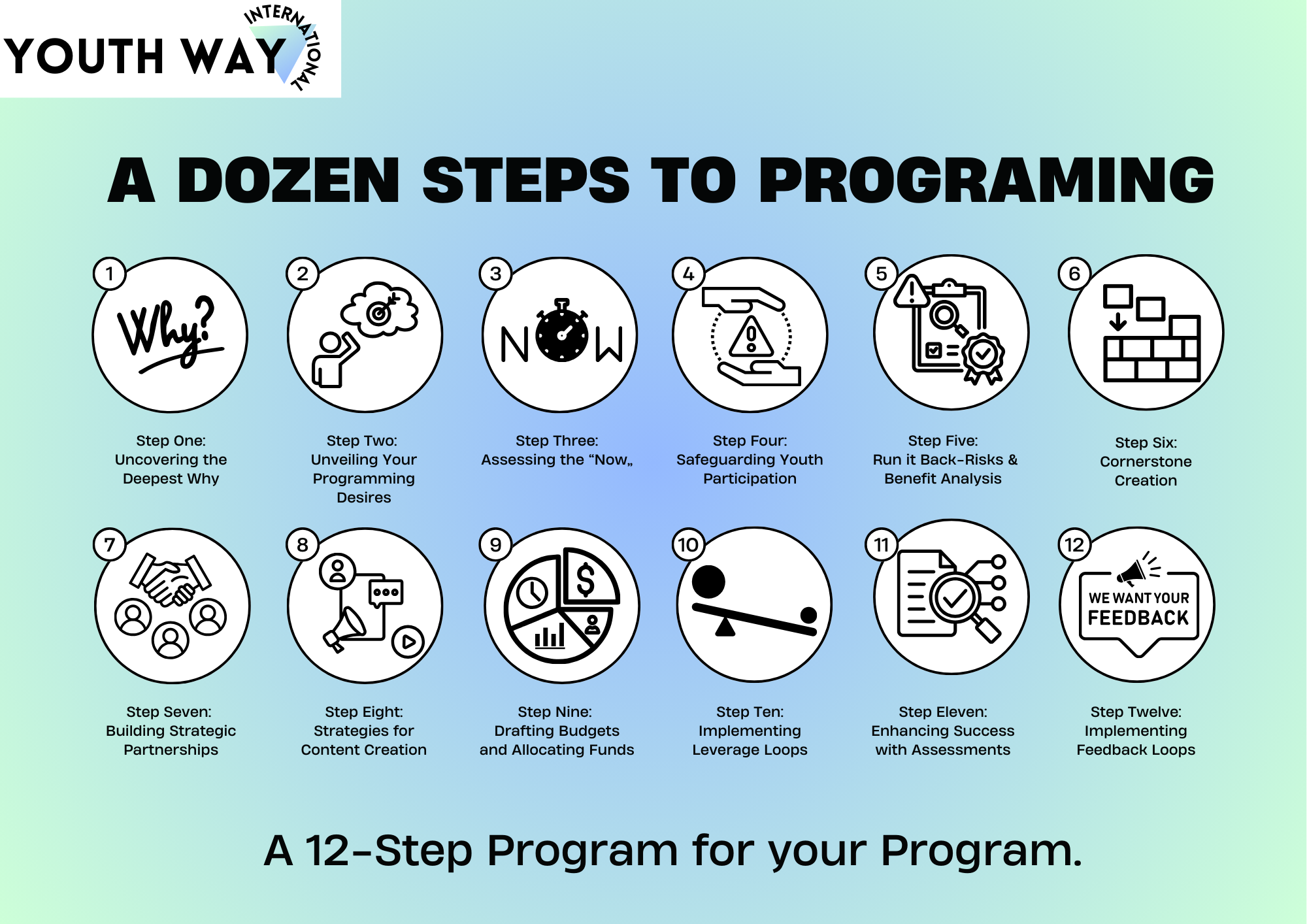
A Dozen Steps to Programming
Program Overview
A Dozen Steps to Programming is a meticulously crafted training program designed to empower professionals from diverse sectors with the requisite skills for proficient project planning and management. Anchored in a systematic 12-step approach, this program is meticulously tailored to instill industry-leading practices for risk mitigation, stakeholder engagement, and the attainment of impactful project outcomes across varying scopes.
Delivered over 12 weeks, our comprehensive training regimen seamlessly integrates 12 hours of immersive virtual sessions with personalized one-on-one coaching, catering adeptly to both seasoned practitioners and aspiring entrants alike. By participating in this program, individuals will emerge as adept planning practitioners, primed to orchestrate projects that are not only captivating but also inherently cognizant of risks, thereby yielding transformative results.
Participants should anticipate allocating an additional 1-2 hours per week for project-related tasks—a modest investment that promises substantial returns in the form of actionable project blueprints. This immersive learning journey not only amplifies your project planning acumen but also positions you to effectuate substantial contributions within your professional domain.
For organizations keen on availing this transformative training opportunity, we are open to discussing bespoke scheduling arrangements on a case-by-case basis, ensuring maximal convenience and efficacy.
Training
What We Offer
Join us once a week for twelve weeks in our hour-long training session. We believe in meeting providers where they are and know how important you are to the team, so we make the most out of this 12-week course by giving you the knowledge, empowerment, and tools to implement what you’ve learned. We are committed to a safe and inclusive space where learning is welcomed.
Organizational Training
A Dozen Steps to Programming can host organizational training for programs with 10 or more participants. The trainees must be committed to completing the course to receive the full benefits and program completion certificate. If your organization is interested in receiving training, please click the link below to provide additional information, and we will reach out within 30 days. Please note that the A Dozen Steps to Programming training is a 12-hour 12-week-long training; however, scheduling accommodations for the training can be considered on a case-by-case basis.
A 12-Step Program for your Program.
-
Why.
Step One: Uncovering the Deepest "Why"
At the heart of every action lies motivation, step one of our program is dedicated to guiding individuals on a journey to uncover their deepest "Why" – the fundamental driving force behind their actions. Going beyond clichés like "I want to help others," Step One encourages participants to delve into the core of their motivations, unraveling the layers of their actions with intention. Through introspective exercises and guided reflection, individuals learn to unearth the authentic reasons that propel them forward in their endeavors.
-
Desire.
Step Two: Unveiling Your Programming Desires
In Step Two of our program, we delve into the crucial process of identifying your programming desires. Just like charting a course for a journey, it's essential to have a clear vision and destination before setting out. We guide you through exercises and techniques to help you uncover your passions, articulate your desires, and align them with your values. By embracing bravery and vocalizing your aspirations, you'll lay the foundation for meaningful and fulfilling programming goals. Step into the realm of possibility and embark on the path to realizing your programming dreams.
-
Now.
Step Three: Assessing the “Now”
“Now” a pivotal stage in our 12-step program framework designed to guide you through the journey of assessing and optimizing your program's progress. In this step, we delve into the present moment, encouraging you to take a reflective pause and evaluate where you stand in your program's development. Now is the time to identify your current position, acknowledging both the benefits and barriers that may influence your program's success. Through a structured analysis, we help you gain clarity on your program's strengths, weaknesses, opportunities, and threats (SWOT), empowering you to make informed decisions and strategic adjustments.
-
Risks.
Step Four: Safeguarding Youth Participation
"Risky Business," we focus on safeguarding the participation of youth and young adults by identifying potential risks and navigating tokenizing tactics. This crucial step involves understanding the current landscape of program participation for this demographic, recognizing common risks, and learning to avoid tokenizing behaviors. By equipping program developers with the knowledge and tools to assess and address risks effectively, we ensure that our programs prioritize the safety, empowerment, and genuine engagement of youth and young adults.
-
Analysis.
Step Five: Run it Back-Risks & Benefit Analysis
“Run it back” involves conducting a thorough risk and benefit analysis., this step is designed to help you mitigate barriers, minimize risks, and maximize benefits, particularly focusing on youth and young adult outcomes. We provide a range of tools to facilitate the analysis process, including SWOT analysis, decision trees, cost-benefit analysis, scenario planning, and risk registers. Running a risk and benefit analysis enables you to anticipate challenges, identify opportunities, and optimize outcomes. By thoroughly evaluating the landscape and considering various scenarios, you can make informed decisions that enhance your program's overall effectiveness and sustainability.
-
Foundation.
Step Six: Cornerstone Creation
Focusing on laying the foundation for success by bringing together all the elements we've identified thus far and crafting a comprehensive action plan. We delve into defining clear objectives, establishing measurable outcomes, and creating a timeline for execution. Additionally, we explore the selection of appropriate tools and technologies to support our program's implementation. By building a strong foundation in this step, we set the stage for effective execution and the attainment of desired outcomes.
-
Partnership.
Step Seven: Building Strategic Partnerships
Partnerships are the heart of successful programs, enabling collaboration, resource-sharing, and collective impact. Within this step, we guide participants through the process of strategically aligning with partners across various sectors. From government agencies to non-profit organizations and private companies, we explore avenues for connecting with like-minded entities. Through targeted outreach, strategic networking, and embedding engagements funnel into their programs, participants learn how to initiate meaningful conversations and forge valuable partnerships. From partnership proposal guides to project management platforms, we empower participants with resources to enhance communication, collaboration, and productivity.
-
Marketing.
Step Eight: Strategies for Content Creation
Our approach focuses on meeting young people where they are, both online and offline, to effectively connect with and inspire them. In step eight discover the psychology behind social media engagement and learn how to craft compelling content that resonates with your audience. Explore proven marketing strategies tailored to different social media platforms, including Instagram, TikTok, and LinkedIn. We'll guide you through the process of building a strong brand presence, developing program-specific content, and implementing a marketing funnel to drive engagement and participation. With our expertise and resources, you'll be equipped to make a meaningful impact in your community and with digital content creation.
-
Finance.
Step Nine: Drafting Budgets and Allocating Funds
Whether you're organizing a community event, launching a new initiative, or managing a program, a well-planned budget is essential for effective resource allocation and decision-making. You'll learn the importance of budgeting and its role in program or event planning. Key considerations in drafting a budget, include goals, expenses, and revenue streams. Whether you're drafting your first budget or looking to enhance your budgeting skills, we provide templates, with step-by-step guides that provide the knowledge, insight, and resources you need to get the most out of every dollar.
-
Leverage.
Step Ten: Implementing Leverage Loops
Get acquainted with the concept of leverage loops in program development by exploring the stages of change and how individuals progress through them, crucial for effective program design. Learn to assess where your service recipients stand in their journey of change, with practical examples, and insights into common barriers. Gain practical strategies for weaving leverage loops into program design, with an emphasis on collaboration and adaptability to apply leverage loops at each stage of change, tailored to specific audience needs.
-
Assessment.
Step Eleven: Enhancing Success with Assessments
Providing invaluable insights into enhancing program success through effective self-assessment covering e topics such as assessment frameworks, identifying systemic gaps and barriers, and mitigating unintended program consequences. Equipping participants with the tools and strategies needed to measure effectiveness and efficiency. From creating surveys to analyzing assessment data and implementing program improvements, we offer practical solutions to drive positive outcomes. Ensuring your programs achieve their intended objectives.
-
Feedback.
Step Twelve: Implementing Feedback Loops
To harness the power of feedback, from identifying stakeholders to implementing data-driven changes. In this last step, participants will learn to craft precise feedback instruments, analyze insights, react to users' comments or anticipate future application of outcomes, and sustain a culture of continuous improvement. Utilizing feedback loops in your program drives outcomes and fosters a continuation of meaningful engagement.

Course Inquiry.
contact@youthwayinternational.com
(423) 620-1929


